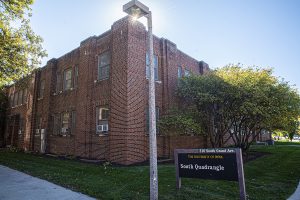Iowa City schools invest thousands into COVID-19 mitigation
This year schools have invested in PPE and other materials to prevent the spread of COVID-19 in their schools.
October 7, 2020
When kids returned to physical classrooms this fall, the materials that students and schools needed to be prepared for class looked different than the traditional supply list of notebooks, pencils and calculators from previous years.
School districts had to plan for providing students and staff members with personal protective equipment, hand sanitizer, and cleaning supplies, while also restructuring the schools to prevent the spread of COVID-19.
The responsibility of planning the Iowa City Community School District’s return to the classroom was split between seven Return-to-Learn teams. Student Services Director Kate Callahan co-chairs the Health and Safety committee. She said the group has met weekly since June to determine COVID-19 mitigation plans, referring to information from the Centers for Disease Control and other medical experts.
The team created a thorough set of district guidelines that explain hallway etiquette, lunch procedure, and physical modification of the schools and classroom cohort expectations, among others. Health and Safety Protocols include a list of PPE and safety materials that the district is providing to schools, staff and students.
Students and staff were provided with two cloth face masks, and staff members were provided with a face shield, according to the district guidelines. Disposable face masks are available on buses and in school buildings. PPE was issued to health-office employees. Other preventative measures and supplies include face thermometers, signage, plexiglass, gloves, cleaning supplies, and hand sanitizer.
Budget and Finances Director for Iowa City schools Leslie Finger said the district has spent $540,000 on these supplies, along with air testing quality, since March 13. The district funneled the money from its cash reserves, and is applying for Federal Emergency Management Agency assistance on eligible expenses.
“The district did receive CARES funding in approximately $1.8 million,” he said. “We have allocated that or reserved that for mostly curricular and instructional needs, such as software, workbooks, Chromebooks, hotspots, and other learning resource materials.”
RELATED: The cost of University of Iowa COVID-19 preparations
Glenn Plummer, junior and senior high principal at Regina Catholic Education Center, estimated that at least $30,000 had been spent on preventive equipment for grades 7-12. That number is not finalized, and some of those expenses will be covered by CARES and ESSER funding — a government grant that provides aid to elementary and secondary schools.
The Elementary Principal Celeste Vincent said COVID-19 created significant expenses, but did not provide an estimated cost of PPE at the elementary school. The elementary school is also receiving CARES and ESSER funding.
“It does cost money to operate a school during COVID,” Vincent said. “We have to spend extra money on clean supplies and on a plexiglass shield for the cafeteria and the plexiglass in the room for the teachers. We have floor signage, and we’re buying duplicates so there’s not shared materials.”
Plummer said that, if teachers ran out of hand sanitizer or masks in their classrooms, the school will supply the materials they need. Some teachers have paid out of pocket for additional plexiglass barriers or their own air circulators so students can work closer together as lab partners.
Regina is installing ionized air circulation machines into all classrooms, pre-K through 12th grade, a project that is supposed to be completed this month, Plummer said.
Callahan said the Health and Safety committee worked with different groups, including the teachers’ union, when making its decisions to identify the district’s needs over the summer.
“What we’ve worked to do is make sure that our teachers and our staff have the items that they need to work and have students in the classroom safely,” she said. “So, if there are additional mitigation techniques that are needed, we are asking staff then to bring them to the district level, have the health and safety committee take a look at that. If it’s something that is needed, then it’s probably needed district wide and we want to make sure we’re equitable with it.”






